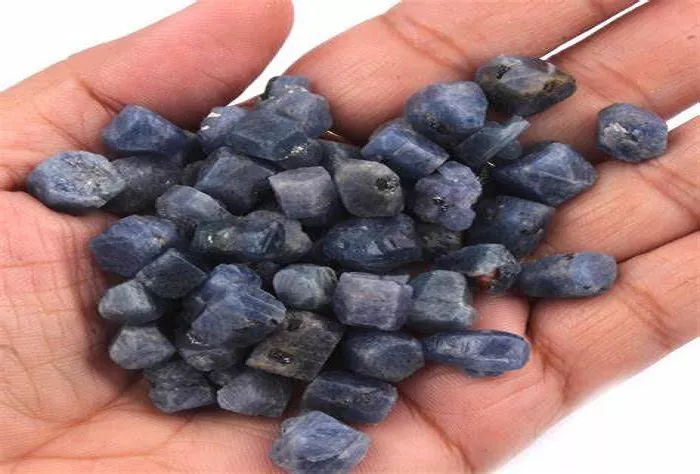Color is the most important factor in pricing uncut blue sapphire. The finest sapphires have a rich, velvety blue hue. This color is often called “cornflower blue.” Some sapphires have a deeper royal blue tone, which is also highly valued. The color should be evenly distributed. If the stone has patches of lighter or darker shades, the price drops. Sapphires with a grayish or greenish tint are less expensive. The most valuable color is pure blue with high saturation.
How Clarity Affects Uncut Sapphire Value
Clarity affects the price of uncut blue sapphire. Sapphires often have inclusions, which are tiny imperfections inside the stone. Some inclusions are acceptable, but too many can lower the value. If the inclusions affect the stone’s durability, the price decreases further. However, some buyers accept inclusions in rough sapphire because cutting can remove them. A skilled cutter can sometimes work around the flaws.
The Role of Size and Weight in Pricing
Size matters in uncut blue sapphire pricing. Larger stones are rarer, so their price per carat increases. A small sapphire may cost less per carat, but a big, high-quality rough sapphire can be very expensive. The relationship between size and price is not linear. A ten-carat sapphire is worth much more per carat than a one-carat stone of the same quality.
Origin and Its Impact on Sapphire Value
Origin plays a role in the price of uncut blue sapphire. Sapphires from certain locations are more sought after. Kashmir sapphires are the most prized because of their exceptional color. However, Kashmir mines are no longer producing much, making these stones extremely rare. Burmese sapphires are also highly valued. Sri Lankan sapphires are more common but still respected for their quality. Sapphires from Madagascar and Thailand are usually less expensive. Buyers often pay more for stones from famous origins.
Market Demand and Economic Influences
Market demand influences uncut blue sapphire prices. When demand is high, prices rise. Jewelry trends, economic conditions, and buyer preferences all play a part. If blue sapphires become popular in engagement rings, demand may increase. If the economy is weak, fewer people may buy luxury gems. The market for natural sapphires fluctuates over time.
Treatments and Their Effect on Price
Treatment is another factor in pricing. Many sapphires are heat-treated to improve color and clarity. Untreated sapphires are rarer and more valuable. Some buyers prefer untreated stones, even if they have slight imperfections. Heated sapphires are still valuable but usually cost less than natural, untreated ones. Other treatments, like diffusion or dyeing, greatly reduce the price.
The Importance of Rough Sapphire Shape and Cutting Potential
The shape of the rough sapphire affects its price. A well-formed crystal is easier to cut, so it commands a higher price. If the rough stone has a good shape, the cutter can maximize the final gem’s weight. Irregularly shaped sapphires may lose more weight during cutting, reducing their value. Some rough sapphires are broken or heavily included, making them harder to work with.
Certification and Its Role in Valuation
Certification adds value to uncut blue sapphire. A report from a respected lab confirms the stone’s quality and origin. Certified sapphires sell for higher prices. Buyers trust labs like GIA, AGL, or Gubelin. Without certification, doubts about treatment or origin may lower the price.
Ethical Sourcing and Mining Conditions
Mining conditions impact supply and price. If a major sapphire mine closes, prices may rise. New discoveries can increase supply and lower costs. Political instability in mining regions can disrupt supply. Ethical sourcing is also a concern. Buyers increasingly want sapphires mined under fair conditions.
Investment Potential and Future Market Trends
The future of uncut blue sapphire prices is uncertain. New mines may be discovered. Lab-grown gems could become more popular. Economic changes may affect luxury spending. However, high-quality natural sapphires will always have value. Their rarity and beauty ensure lasting demand.
Conclusion
In conclusion, uncut blue sapphire prices depend on many factors. Color, clarity, size, origin, and market trends all play a role. Buyers must carefully evaluate each stone. Experience and knowledge are essential. While prices fluctuate, the best sapphires remain valuable. Whether for cutting, collecting, or investment, understanding these factors helps in making wise decisions. The allure of blue sapphires ensures they will always be treasured.
Related Topics:
- What Does a Rough Sapphire Look Like?
- What to Look for When Buying a Sapphire?
- Is Sapphire Cheaper Than Diamond?


